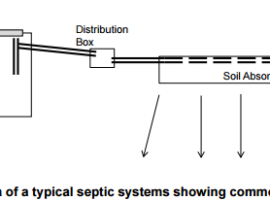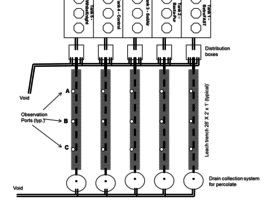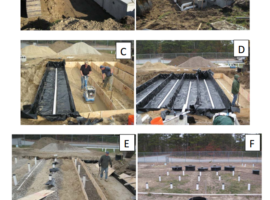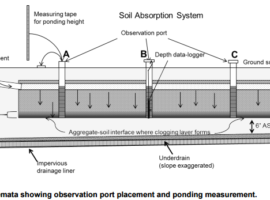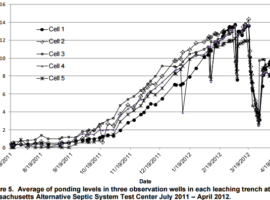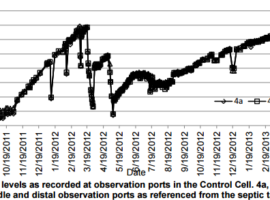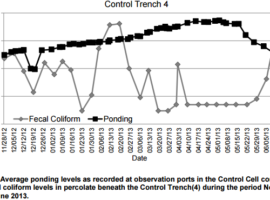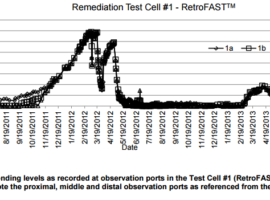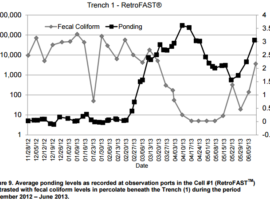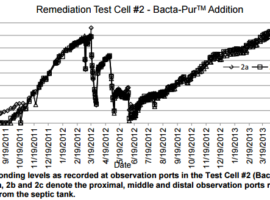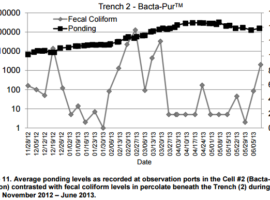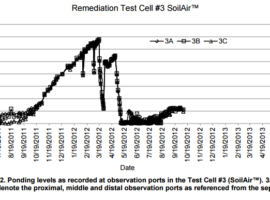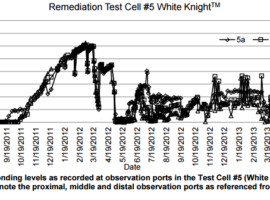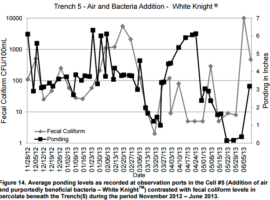The Effect of Selected Treatment Technologies on the Hydraulic Function of Stressed Onsite Septic Soil Absorption Systems – The Results of a Pilot Test Protocol
Authors: George R. Heufelder M.S. R.S., Keith Mrozcka B.S.Published: 2013
This project was funded in various proportions by the Massachusetts Department of Environmental Protection with funds from the United States Environmental Protection Agency under the Section 319 Competitive Grants Program. The grants were made to the Barnstable County Department of Health and Environment, the operators of the Massachusetts Advanced Septic System Technology Center. The contents of these reports do not necessarily reflect the views or policies of the departments mentioned nor does the mention of any products, trade names, or companies constitute an endorsement.
Abstract
Many communities in the Commonwealth of Massachusetts are engaged in wastewater management planning. This process is often extended in coastal communities because multiyear environmental assessments are required to adequately determine treatment needs. Extended planning periods often result in the needless expenditures of funds to replace septic systems where more centralized options are likely. In order to provide tools to avoid these expenditures, the Massachusetts Alternative Septic System Test Center with support under the Commonwealth of Massachusetts 319(b) Competitive Grants Program endeavored to develop and conduct a protocol to test products that purportedly extend the “life” of a soil absorption system and restore lost hydraulic function. By identifying such products/strategies, communities might allow individuals to forego more-expensive repair options in areas where the elimination of septic systems is imminent and preserve capital that might be used for alternative wastewater treatment options.
Four different technology types capable of being used or retrofitted on existing systems were chosen for testing: addition of purportedly “beneficial” microbes, the introduction of air into the septic tank along with purportedly-beneficial microbes, the introduction of air alone into the septic tank and the introduction of air into the soil absorption system (SAS) directly. Hydraulic function and treatment were compared with a control situation to which no treatment was provided. This report focuses on hydraulic function elements of the SAS, however the consequences of restored hydraulic function to treatment for pathogens was also investigated. This later portion of the investigation was completed by sampling the percolate beneath the SAS following six inches of passage through sand meeting the specification of ASTM C-33.
In order to provide comparable test conditions that simulate a stressed or “failed” condition, a regimen of hydraulic loading up to five times the allowable rate (Long Term Acceptance Rate or LTAR as specified in Massachusetts CMR 15.0001 ) was provided. The stressing period, took approximately ten months. Following this period, the manufacturers’ products were applied in accordance with their respective standard installation/application procedures.
Of the four products tested, the introduction of air alone into the septic tank (RetroFAST™) was the most effective means of restoring hydraulic function. Although the SoilAir™, which introduces air directly into the soil absorption system, showed promising ability to restore the hydraulic function during its operation, the test of this product was discontinued due to the inability to isolate these effects from the other test cells. The introduction of air with purportedly beneficial microbes (White Knight™) also demonstrated generally-beneficial results, however the ponding levels within that test cell were variable, sometimes indicating ponding to 50% of the storage elevation of the trench. We also observed the refusal of septic tank effluent into the leaching trench on two occasions. The manufacturer posits that the wastewater source contained more non-organic components than typical of household wastewater, and that the accumulation of this material restricted the necessary air flow within the treatment unit. The introduction of purportedly-beneficial bacteria alone showed no discernible effect and ponding levels in that trench were similar to the control. It should be noted that this study, which tested only one of over fifty products available that purport to have a beneficial use, may not be indicative of the full range of bacteria/organism additives available on the market.
The reader is reminded that the protocol used in this study may not be an indicator of longerterm performance and maintenance of hydraulic function due to time and resource constraints of the test. Nevertheless the data presented suggests that certain strategies may be beneficial in the short run (up to at least two years) to avoid the large capital expenditure of septic system replacement in areas where alternative solutions to wastewater management are imminent. It should also be noted that the performance of the specific products mentioned may not be indicative of the performance of all products in a class of products/strategies.
The testing protocol used appears to provide a useful means to test restorative products. These researchers believe that the hydraulic loading regimen carried out in this study represents an appropriate test-case scenario for household organic and hydraulic loading for testing the efficacy of such technologies.
The testing protocol used appears to provide a useful means to test restorative products. These researchers believe that the hydraulic loading regimen carried out in this study represents an appropriate test-case scenario for household organic and hydraulic loading for testing the efficacy of such technologies.

